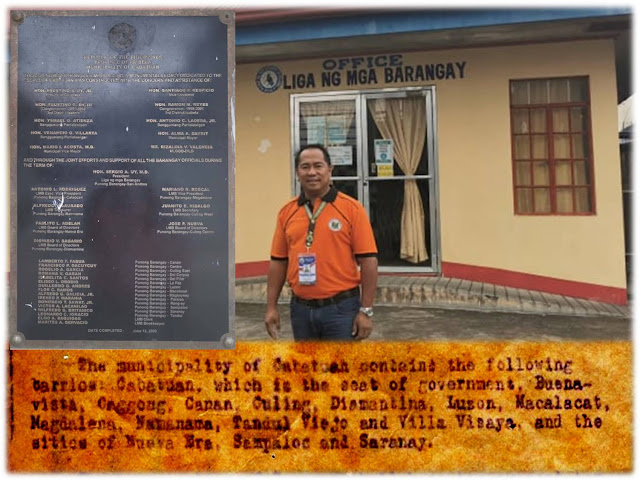124. EVOLUTION OF THE BARANGAYS OF CABATUAN
EVOLUTION OF THE BARANGAYS OF CABATUAN
Dr. Troy Alexander G. Miano
05 November 2020
During the same period, another group of Bacarreños settled upstream the Magat and named their village as “Villa Visaya”. In the 1940s, Villa Visaya expanded and another community was born and was named as “Diamantina”.
In the 1920s, the two barrios of Sarrateña and San Lucas were formed by Ilocanos from Laoag and Sarrat in Ilocos Norte. The great flood of 1936 by the Magat submerged the San Lucas territory prompting its residents to merge with the neighboring barrio. In 1946, the barrio was renamed to “Luzon”.
Also in the
1920s, pioneering Ilocanos from Ilocos Sur, migrated to southern Isabela and
settled along the banks of the Magat and in 1932 the new settlement was
christened as “Culing”.
In 1924,
Ilocanos from Laoag settled along the Macañao River near Sarrateña and formed a
neighborhood named “Canan”.
In 1938, Pangasinenses
from Tayug settled near the Macañao River and formed a community christened as
“Katayugan”. In 1941, it became a barrio and renamed to “Namnama”.
After the Second World War, Barrio Cabatuan became populated and expanded its residential areas inland. Cabatuan was divided into districts and eventually one of the districts boomed and was named as “Magdalena”.
Upon the creation of Cabatuan on November 5, 1949, eleven barrios were extracted from the mother-town of Cauayan. They were: Cabatuan, Buenavista, Caggong, Canan, Culing, Diamantina, Luzon, Macalaoat, Magdalena, Namnama and Villa Visaya. The three sitios were: Nueva Era, Sampaloc and Saranay. Barrio Tandul Viejo, on the other hand, was dismembered from San Mateo town and joined the newly minted municipality of Cabatuan.
In 1951, a major re-organization was made creating the new barrios of: Calaocan (from Culing), Centro East (from the old Barrio of Cabatuan-poblacion), Centro West (from the old Barrio of Cabatuan-poblacion), La Paz (from Canan and Namnama), Nueva Era 1 (from Culing), Nueva Era 2 (from Culing), Sampaloc and Saranay. Barrio Buenavista, on the other hand, was joined with Barrio Caggong while Barrio Villa Visaya was also incorporated with Barrio Diamantina.
In 1956, two additional barrios were formed. Barrio Del Pilar was created from Magdalena while Barrio Del Corpuz was extracted from Nueva Era 1.
In 1964, Barrio Centro West was renamed to “T. Abad” honoring one of the founders of Cabatuan, Señor Teodoro Abad while Barrio Centro East was simply called “Centro”. Also the same year, Barrio Caggong was re-christened to “Rang-ay” while Barrio Tandul Viejo was simply called “Tandul”. Barrio Nueva Era 1 was renamed to “Culing West” while the remaining fraction of old Culing was called “Culing East”. Barrio Nueva Era 2 was plainly called “Nueva Era”.
In 1969, Barrios Culing East, Culing West and Del Corpuz were chopped to accommodate a new barrio and named Culing Centro.
The continuous re-organization of the barangay administrative and political set-up divided Barrio Macalaoat and in 1972, the Barrios of Magsaysay and Paraiso were created. The territory of Barrio Magsaysay was derived from the western portion while Barrio Paraiso got its land area at the eastern side of Macalaoat. Also in the same year, Barrio T. Abad was again renamed to “San Andres” to honor Cabatuan’s patron, Saint Andrew the Apostle.
Today, the Municipality of Cabatuan has 22 barangays, namely: Calaocan, Canan, Centro, Culing East, Culing Centro, Culing West, Del Corpuz, Del Pilar, Diamantina, La Paz, Luzon, Macalaoat, Magdalena, Magsaysay, Namnama, Nueva Era, Paraiso, Rang-ay, Sampaloc, San Andres, Saranay and Tandul.




Mga Komento
Mag-post ng isang Komento